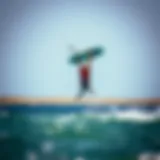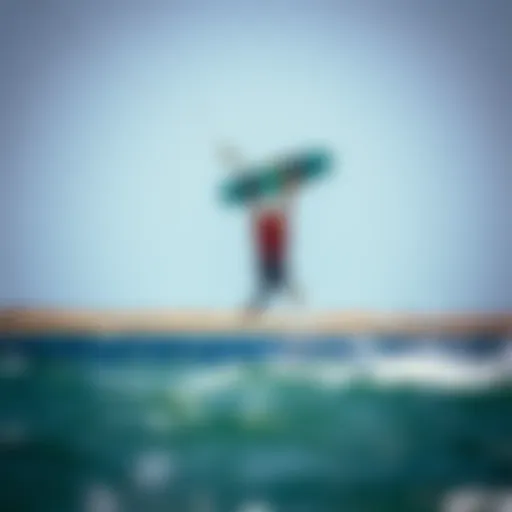Mastering High Wind Kiteboarding Techniques
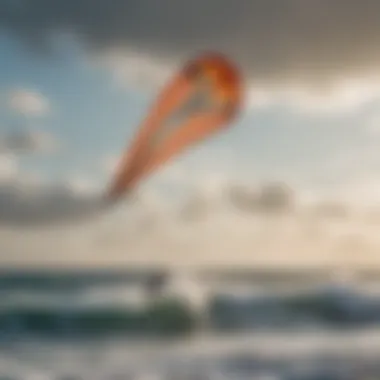

Intro
Kiteboarding is as much an art as it is a sport, especially when it involves high wind conditions. For those who have felt the rush of cutting through waves while tethered to a powerful kite, there's nothing quite like it. However, high winds present unique challenges and opportunities that require a keen understanding of technique and equipment. Whether you're riding through a light breeze or a fierce squall, mastering kiteboarding in heightened conditions can elevate your experience to a whole new level.
This guide will explore vital aspects related to high wind kites, aiming to provide valuable insights for kiteboarding enthusiasts. We'll take a look at various techniques necessary for beginners and seasoned riders alike, gear recommendations tailored for high wind conditions, and insights into wind dynamics that can make or break your ride.
Understanding the unique characteristics of high wind kites not only enhances safety but also fine-tunes performance. In this journey across stiff breezes and raging gusts, one can appreciate the art of balancing control and thrill. Let's dive into the intricate details that shape the foundation of successful kiteboarding in challenging conditions.
Understanding High Wind Kite Dynamics
The dynamics of high wind kites represent a crucial cornerstone for kiteboarding enthusiasts and professionals alike. Understanding how different elements interact under increased wind conditions can significantly dictate performance, safety, and riding enjoyment. With unpredictable gusts and intense speeds, recognizing kite dynamics is like picking grapes at the right time—they can affect the quality of your ride.
High winds pose unique challenges, so grasping these dynamics helps kiteboarders make informed choices about gear selection and techniques. Kite shape, stability, and material properties all influence how a kite behaves when gusts pick up. This understanding is especially beneficial for instructors seeking to train new riders or for enthusiasts intending to sharpen their skills in varying wind conditions.
The Impact of Wind Speed on Kite Performance
Wind speed acts as the primary driver of a kite's performance. As the wind picks up, the uplift on the kite increases, thus generating more power. However, this power can be a double-edged sword. If a kite's design isn't suited to handle strong winds, it might lead to instability or even damage. Understanding the specific wind range of a kite helps riders avoid unwanted scenarios like a broken line or a kite that tumbles out of control.
For example, many high wind kites are specifically designed with reinforced structures to withstand greater tensions. They might perform optimally between 20 to 30 knots, but exceeding these limits could lead to disaster, turning a joyride into a precarious situation. Being able to gauge wind speed accurately before hitting the water is paramount.
How Kite Shape Influences Stability
The shape of a high wind kite plays a key role in its stability. Generally, kites with a flatter profile tend to handle higher wind speeds better by presenting less surface area to the wind. On the flip side, more rounded kites may offer better lift but can be less stable when gusts arise.
Moreover, a kite’s aspect ratio—the ratio of its width to its height—factors into performance. High aspect ratio kites may slice through the air effectively in strong winds, but they may be harder to control for novice riders. Therefore, picking the right shape is essential to not only achieve desired performance but also ensure safety on the water.
Material Considerations for High Wind Kites
When it comes to kites, the materials they’re made from can be a game changer. Here are some vital aspects to consider:
Fabric types
The fabric used in kite construction not only affects performance but also durability and handling in high winds. Common materials like ripstop nylon and polyester are popular due to their lightweight and durable nature. These fabrics offer a high tensile strength, providing resistance against tearing.
However, there are varying grades and weaves that can further enhance performance. Some fabrics come with UV coatings to resist sun damage. This characteristic is particularly beneficial when kiteboarding in locations with long sun exposure, keeping the kite in good shape season after season. On the downside, heavier fabrics can diminish lift, potentially causing issues in ultra-light conditions.
Reinforcement techniques
Reinforcement techniques are best regarded as the backbone of high wind kites. Techniques like stitching reinforcements at stress points and using additional patches where needed can be paramount. These methods bolster the kite’s resilience under the strain of heavy winds, significantly reducing the chances of wear and tear.
For instance, employing double stitching or extra seams in high-pressure areas can enhance kite longevity. However, it's essential to note that extensive reinforcements can add weight, which may compromise performance in specific conditions or reduce agility during maneuvers.
Weight vs. Durability
The balance between weight and durability in kite construction is a delicate dance. Lighter kites can be easier to handle but might sacrifice some strength. Heavy-duty materials provide excellent durability but can hinder performance, especially in lighter winds. Therefore, understanding your style and conditions is crucial.
For example, a rider who prefers aggressive jumping in high winds may lean toward a super-durable kite, accepting the weight for added confidence upon landing. Conversely, someone seeking swift speed in gusty conditions may opt for something lightweight, trading off durability.
"Choosing the right materials is like tailoring a suit—getting it right can make all the difference in performance."
In summary, understanding kite dynamics, especially under high wind conditions, is more than just knowing how to pull a string. It requires a blend of knowledge, intuition, and experience. As kiteboarding continues to evolve, those who grasp these complexities will undoubtedly enjoy a more satisfying experience.
Choosing the Right High Wind Kite
Selecting the appropriate kite for high wind conditions can be the difference between soaring triumphantly over the waves and being tossed around like a rag doll. Given the capriciousness of nature, making an informed decision about your kite can significantly enhance your experience on the water. The right kite not only improves performance but also bolsters your safety in unruly environments. A wise choice reflects the understanding of specific elements such as kite size, shape, and brand offerings, which all bear weight on your performance.
Identifying Appropriate Sizes for Wind Conditions
The wind is a fickle friend. Too much power, and you’re facing a battle; too little, and you’re stuck idle. Kites come in various sizes, and understanding which one is apt for the current wind conditions involves a bit of finesse. Usually, smaller kites handle stronger winds better due to their reduced surface area, which helps mitigate excessive lift and offers more control. Conversely, larger kites become unwieldy when the winds pick up, leaving the rider less maneuverable.
Here’s how you might break it down:
- Light Winds (10-15 knots): Look for a kite size that complements the lighter conditions.
- Moderate Winds (15-25 knots): A balanced approach often works here, adapting slightly larger kites depending on personal preference.
- Strong Winds (25 knots and above): Smaller kites are advisable — they provide the stability needed to keep you grounded while still allowing for that exhilarating ride.
Understanding how your kite performs under different wind circumstances is crucial for enjoying every moment on the water.
Comparing Different High Wind Kite Models
When you're stuck wondering which kite to take out, you might find yourself looking at different models. It's vital to comprehend the distinctions between various types of kites, as each comes with its advantages and disadvantages. Let's dive deeper into the types.
Freestyle vs. Freeride Kites
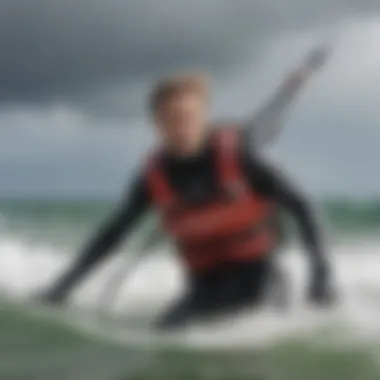

Freestyle and freeride kites serve different rider aspirations and environments. Freestyle kites tend to be designed for performance in tricky moves and tricks. They’re often characterized by a lower aspect ratio which affords better control and response during such maneuvers. This aspect allows experienced riders to harness wind power effectively for aerial feats.
On the flip side, freeride kites emphasize versatility and ease of use. They tend to possess a higher aspect ratio, enabling more lift in varied conditions. Beginners and those looking for a more forgiving ride often favor freeride kites due to their stability and predictable behavior in strong winds.
Each style boasts its own merits:
- Freestyle Kites:
- Freeride Kites:
- Maneuverability for tricks.
- Responsive under changing conditions.
- Great for a range of skill levels.
- More forgiving with a wider wind range.
Specific Brands and Their Offerings
When it comes to high wind kites, some brands stand out due to their commitment to quality and innovation. For instance, brands like Naish and Cabrinha have a reputation built on years of expertise in kite design. They provide kites specifically engineered for high wind settings, taking into account various performance criteria, including durability and maneuverability.
Naish, for instance, offers kites that excel in gusty conditions—ideal for maintaining control, even when things get wild out there. On the other hand, Cabrinha has designed its kites with features focused on user feedback, ensuring they meet the desires of modern riders.
These brands not only provide kites but also nurture a community of enthusiasts, promoting safety and skills development.
User Reviews and Feedback
Reviews from fellow riders play an instrumental role in guiding your purchase. Websites and forums often act as platforms where users can share their experiences. Looking through user reviews might point out essential details you might’ve overlooked, from how the kite performs in choppy conditions to its longevity under exertion.
Additionally, feedback reveals the personal preferences of riders at various skill levels, providing insights on how particular models handle specific wind conditions. Knowing what seasoned kiteboarders think about their gear can give you a clearer picture, leading you towards a kite that is widely praised or one you might want to avoid.
In summary, choosing the right high wind kite encompasses various elements, from sizing based on wind conditions to understanding the nuances between models and considering brand reputation. It’s about aligning your kite with your riding style and the conditions you plan to tackle, ensuring each ride is exhilarating yet safe.
Techniques for Maneuvering in High Winds
Kiteboarding in high winds offers both exhilarating freedom and intricate challenges. Mastering techniques for maneuvering in these demanding conditions is vital not just for your enjoyment but also for your safety. When the wind picks up, it demands a different kind of finesse and control. The combination of strength, agility, and understanding how your body interacts with the board and kite becomes essential. Getting it right can transform a potentially dangerous experience into one where you feel in command, gliding freely over the water while harnessing the power of the wind.
Adjusting Your Stance and Body Mechanics
Your stance on the board is crucial during high winds. A balanced position means more than just standing upright. In strong gusts, bending your knees and lowering your center of gravity helps maintain stability. Here’s how to refine your stance:
- Feet Placement: Position your feet shoulder-width apart, but don’t be afraid to adjust based on the wind's intensity. Wider may feel more stable in extreme conditions.
- Knees Bent: Always keep those knees soft. A slight bend acts like shock absorbers against unexpected wind shifts.
- Hips Open: Orient your hips towards the kite. This alignment not only gives you better control but also prepares you to react swiftly to changes in wind conditions.
Additionally, your body mechanics play a pivotal role. Tension is to be avoided; a relaxed upper body allows for smoother movements. Think fluid -- your body should follow the kite and board as an extension of your will.
"Adjusting your stance can be the difference between soaring like an eagle and wiping out like a clumsy fish."
Practicing these adjustments in various wind conditions helps ingrain them into muscle memory.
Mastering Speed Control and Pressure Management
Speed control is another cornerstone of kiteboarding in high winds. When wind speeds increase, the amount of power transferred to the kite escalates, and so does the need for a deft touch on the controls.
To manage speed effectively:
- Use the Harness: This device is key in high winds. A well-fitted harness should distribute pressure evenly across your body. Knowing when to pull on the harness versus when to ease off will help you ride the wind without unnecessary strain.
- Edge Your Board: Leaning back and edging your board against the water creates resistance which stabilizes your ride. Engage your heels to pull against the wind while finding the right balance.
- Trim the Kite: Adjusting the trim gives you a direct hand in pressure management. By altering the angle of the kite concerning the wind, you can increase or decrease the pull dramatically.
- Stay Light on Your Feet: Shift your weight dynamically and keep your center of gravity moving. The more reactive you are to the kite’s movements, the better you will control your speed.
Finding the sweet spot where the kite pulls without overwhelming you is an art. Experimentation and experience will carve your path to mastery. Becoming adept in these techniques not only enhances your riding experience but builds confidence to tackle the high winds head-on.
Safety Precautions for High Wind Kiteboarding
When engaging in kiteboarding, especially in high winds, safety is not just a choice; it's a necessity. The conditions experienced can be unpredictable, and if not prepared, the risks involved can escalate quickly. Riders must approach high wind kiteboarding with both respect and understanding for their surroundings. Awareness is your first line of defense. Navigating the complexities of strong gusts and turbulent air can be daunting, but by mastering safety precautions, you improve your chances of an enjoyable experience, whether you are a fledgling kiteboarder or a seasoned pro.
Recognizing Hazardous Wind Conditions
Before hitting the water, it is essential to assess wind conditions accurately. High winds can vary drastically based on time of day, local geography, and weather systems. Always carry a reliable wind gauge or use an app to get real-time updates. When winds exceed your kite's recommended range, it’s usually best to hold off. Additionally, certain signs can indicate potential hazards:
- Gustiness: If the wind is shifting in intensity, don’t take it lightly. Gusts can quickly turn fun into intimidating, shifting your control without notice.
- Visual Indicators: Look for whitecaps forming on water or the way trees sway. If branches are moving wildly or debris is flying about, those are pretty good indicators to steer clear.
- Weather Changes: Keep an eye on clouds. Dark, looming skies or sudden temperature drops are red flags.
Safety Gear and Its Importance
A well-prepared kiteboarder always prioritizes safety gear. The right equipment protects you from injuries and helps keep you on track, enhancing your overall experience. Remember, being careful doesn’t mean you can't have fun; in fact, safety measures can elevate your enjoyment significantly. Here’s a closer look at two critical components of safety gear:
Harness Types
When it comes to kiteboarding, choosing the right harness can make a world of difference. Harnesses come in different styles: seat harnesses and waist harnesses, each with its advantages.
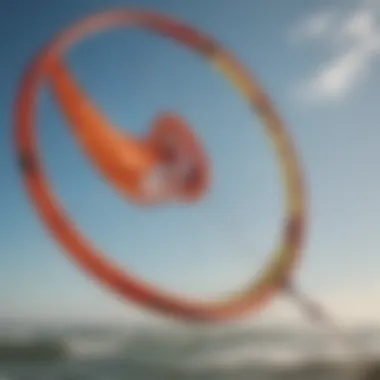

- Seat Harnesses: Known for their safety features, they provide snug support around the buttocks and lower back. This style keeps the center of gravity low and often stops riders from being pulled off their board.
- Waist Harnesses: These are popular for their freedom of movement. They allow for more flexibility but can under certain conditions lead to back strain.
Riders might opt for a seat harness in high winds. Despite being bulkier, it tends to keep you anchored, providing essential control during those lofty gusts.
Impact Vests and Related Gear
Another pivotal piece of safety equipment is the impact vest. They serve as protective buffers against falls, ensuring vital organs are cushioned from potential injuries.
- Key Characteristic: Impact vests are designed to absorb shock better than standard life jackets. This feature is crucial as falling from a height can have significant consequences.
- Unique Features: Many modern impact vests come with adjustability features and extra buoyancy that doesn't slow you down. However, in a pinch, they might feel restrictive, so finding one that fits your style is vital.
Opting for an impact vest can be a game changer when you take that unexpected tumble during a high wind session. Ultimately, those few moments of discomfort can pale in comparison to the protection they offer.
Emergency Procedures During High Winds
Preparation doesn’t stop at selecting gear. It’s equally important to have emergency procedures in play. Before every outing, make sure your plans include what to do in an emergency scenario. Key tips to consider include:
- Communication: Always let someone know your riding plan. Keep a mobile device handy in case you need to establish contact.
- Wind-down Routine: When conditions seem to be escalating, practice your wind-down technique—know when to safely land your kite.
- Quick Release Mechanism: Master your quick release and ensure you practice it regularly. Efficiently understanding this mechanism can save you from potential hazards quickly.
By thoroughly understanding the dynamics around safety precautions in high wind conditions, kiteboarders can enjoy their adventures with confidence. Remember, merging caution with skill is the key to successfully navigating the thrilling world of kiteboarding.
Gear and Equipment for High Wind Conditions
When it comes to kiteboarding in strong winds, the choice of gear and equipment can make a significant difference. High wind conditions demand specialized equipment that is both durable and efficient. Choosing the right components not only ensures better performance but also keeps riders safe. Let's dive deeper into the essentials.
Specialized Boards for High Winds
Board sizes and shapes
The size and shape of a kiteboard can greatly affect how it performs in high-wind scenarios. A shorter board tends to be more maneuverable, while longer boards provide stability and speed. Many riders opt for boards that are wider to increase surface area; this helps in planning and controlling speed. A key characteristic of these boards is their ability to handle more powerful kites without losing grip on the water.
This stability allows for more aggressive riding and better handling, especially when the wind kicks up. However, a wider board can sacrifice some speed when the winds are lighter, making it less versatile in varying conditions.
"In high winds, having the right board can feel like wielding a sword instead of a stick – it transforms the ride entirely."
Material composition
Material composition is equally crucial when selecting a board for high winds. Most high wind boards are made from materials like fiberglass, carbon fiber, or a combination of both. These materials provide strength while minimizing weight. A key benefit of using carbon fiber is its rigidity, which allows for quick and responsive performance in gusty conditions. However, it comes with a cost, as carbon boards can be pricier than their fiberglass counterparts. On the other hand, fiberglass boards may be heavier but are often more forgiving, suitable for those still mastering their skills. The choice here often comes down to balancing performance needs against budget.
Harness Options Suitable for High Winds
Harnesses also play a pivotal role in high wind kiteboarding. It is essential to choose a harness that offers support while allowing for maximum mobility. Look for harnesses made from high-quality materials that feature quick-release systems for emergencies.
Waist harnesses tend to be popular among those who prefer a low center of gravity. In contrast, seat harnesses provide more support for heavy winds, especially for beginners who might not yet handle the pressure effectively.
The key is to ensure the harness fits snugly without digging into the body, allowing for prolonged comfort during extended sessions on the water.
Adjustments and Tuning for Optimal Performance
Tuning your gear can significantly enhance performance, especially in turbulent conditions. Small adjustments in the trim of your kite or the stance of your board can lead to better control.
The lines of the kite, for instance, should be properly tensioned to keep the kite flying efficiently, avoiding slack that could lead to crashes. Similarly, adjusting the angle of attack on your kite by shifting the bar can help in controlling power and maintaining stability against strong winds.
Ultimately, taking the time to fine-tune your equipment can turn a good ride into a great one, providing confidence to push limits in high-wind conditions.
Environmental Factors Affecting High Wind Kiteboarding
Understanding how environmental factors influence kiteboarding is crucial for both safety and performance. The dynamics of high winds can vary significantly due to fluctuations in temperature, humidity, and geographical features. By recognizing these elements, kiteboarders can better prepare for the conditions they will face and enhance their riding experience.
Understanding Thermal and Gradient Winds
Thermal winds arise from differences in temperature. When the land heats up during the day, it creates a pressure difference that leads to uplifting air. As this warm air rises, cooler air from surrounding areas rushes in to replace it, generating steady wind conditions ideal for kiteboarding. This creates a natural lift that kites can take advantage of, allowing for improved performance in high winds. A solid grasp of thermal winds can give riders the edge they need to master challenging conditions.
The Influence of Geography on Wind Patterns
Geographical features significantly impact local wind conditions, with variations depending on whether you’re near coasts or in urban settings.
Coastal winds
Coastal winds are often characterized by their predictability and strength. They typically result from the temperature difference between land and sea. During the day, land heats up faster than water, producing winds that can provide exhilarating riding experiences.
- Key characteristic: These winds are generally consistent, especially in the afternoon, making them favorable for kiteboarders.
- Benefits: Since they are often stronger and more consistent than inland winds, coastal winds are a popular choice for riders looking for reliable conditions.
- Unique Features: The proximity to the ocean often leads to the creation of small waves, offering additional fun for those who enjoy jumping and tricks.
- Drawbacks: However, coastal winds can bring about unexpected gusts, meaning boarders must stay attentive to changes.
Urban environments
Urban areas, while less conventional for kiteboarding, present their own unique wind patterns. Buildings, schools, and bridges can create turbulence or wind shadows, leading to unpredictable riding conditions.
- Key characteristic: Winds in these areas can be erratic, shifting direction and intensity frequently.
- Benefits: If you understand the lay of the land, urban kiteboarding can lead to unexpected thrills and the ability to ride in otherwise calm conditions.
- Unique Features: Urban landscapes can sometimes funnel wind, increasing speeds in certain areas. However, they can also cause strong downdrafts that are dangerous.
- Drawbacks: The unpredictability poses risks, especially for less experienced riders who may struggle to respond to sudden wind changes.
In summary, grasping the environmental factors that affect kiteboarding in high winds can significantly impact your performance and safety. Whether you're riding on the coast or navigating through urban settings, knowing how to read the wind allows you to seize the moment and truly master the art of kiteboarding.
Global Regions Known for High Wind Conditions
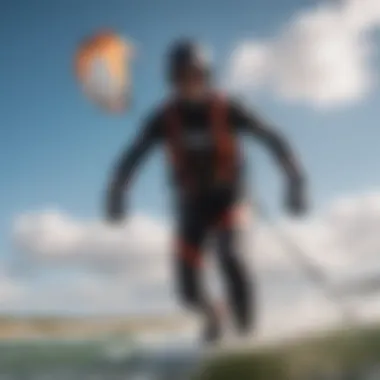

Understanding where to kiteboard in high wind conditions is crucial for both safety and enjoyment. Certain regions around the globe are fabled for their consistent, powerful winds, creating ideal setups for kiteboarding enthusiasts. These locations not only provide the winds necessary to master high wind kites but also present unique challenges that help riders sharpen their skills. Knowing these regions allows kiteboarders to plan trips that promise excitement, camaraderie, and the thrill of riding mini storms.
Top Kiteboarding Destinations
Spot evaluations
When considering a kiteboarding spot, evaluating its characteristics can make or break your experience. Factors like wind consistency, local regulations, and the type of launch area significantly contribute to a location's reputation. For example, Hood River in Oregon is regarded as a mecca for experienced kiteboarders due to its reliable winds and scenic backdrop. The Columbia River Gorge funnels winds, often gusty, making it an exhilarating place to ride.
Beyond wind intensity, evaluating the facilities and local community is also key. This area boasts a range of amenities, from shops selling quality kite gear to schools offering lessons. Surrounded by likeminded individuals, there's a sense of camaraderie that's hard to replicate elsewhere. However, intense winds can also present downsides, such as challenging conditions that can intimidate less experienced riders.
Seasonal considerations
Different regions experience varied wind patterns throughout the year, and understanding these cycles is essential. For instance, Maui's north shore typically sees strong trade winds during the summer months, creating a bustling atmosphere for kiteboarding. Many riders flock to this destination during the peak season, as the forecast during these months skills inspirations and ensures great conditions.
Yet, every season has its pros and cons. The winter months, complex in wind dynamics, introduce unpredictable gusts and stronger waves that are better suited for advanced riders. However, for beginners, these conditions might pose safety concerns. Taking the time to observe and understand seasonal patterns equips kiteboarders with knowledge to choose the best time for their visit, enhancing enjoyment and safety.
"Embracing the wind and understanding its language is key for anyone navigating the high-wind kiteboarding world."
Taking into account both spot evaluations and seasonal considerations, kiteboarders can better select their locations. Delving into the aspects of wind consistency, local culture, and seasonal patterns will not only enrich experiences but contribute to increased confidence on the water.
Community Perspectives on High Wind Kiteboarding
Engaging with the kiteboarding community reveals invaluable perspectives that can enhance one’s experience in high wind conditions. Often, it is not just the technical know-how or gear that defines success on the waves, but the collective wisdom of experienced kiteboarders. Their input is crucial, as they have navigated similar challenges and can provide insights beyond the usual instructional content.
One of the key elements that emerge from community interactions is the sharing of personal anecdotes. Newcomers are often eager to hear about the trials and triumphs faced by those who came before them. This exchange creates a sense of belonging and camaraderie, fostering an environment where learning out of failures becomes as important as celebrating victories. The kiteboarding community frequently gathers at local beaches, where informal discussions about known hazards, favorite setups, and successful techniques thrive. These conversations can help newcomers dodge avoidable pitfalls, giving them a leg up.
Furthermore, understanding the local kiteboarding culture adds an additional layer of nuance. Every region can have unique wind conditions, local comforts, and regulations that are not commonly addressed in formal guides. Getting acquainted with local riders means one can easily tap into localized knowledge, which often leads to safer and more enjoyable sessions.
Community events, such as kiteboarding competitions or casual meetups, are also essential. They showcase various skill levels and styles, allowing enthusiasts to observe and learn in real-time. These gatherings frequently foster mentorship opportunities, enabling less experienced riders to seek out seasoned pros who are eager to share techniques and safety tips.
"The ocean's rhythm is best understood through shared experiences, not just textbooks."
Contributions from Experienced Riders
Experienced riders can be a treasure trove of information. They have the capability to identify subtle differences that impact performance during high wind kiteboarding, something that often goes unnoticed by the novice. These contributors share their personal setups, detailing adjustments made to kite size, line length, and board type based on wind conditions. Observing how they adapt can lead to meaningful enhancements to one’s own style.
Additionally, these riders often discuss the mental side of kiteboarding in high winds. Mental strength and adaptability become just as important as physical skill when facing unpredictable gusts and rapid changes in conditions. The experienced riders frequently advocate for honing one's mental game—the resilience to remain calm in challenging moments can mean the difference between a thrilling session and a disastrous one.
Regulatory Insights and Compliance
Part of participating in the kiteboarding community involves understanding the broader regulatory landscape. Compliance with local laws ensures not just your safety, but that of others. Experienced kiteboarders often take the initiative in educating newcomers about any regional restrictions or guidelines specific to high wind conditions.
- Local Regulations: Many beaches have specific kiteboarding rules during strong wind months or peak season. Knowledge of these regulations helps maintain a positive community reputation and avoid potential fines.
- Safety Protocols: It’s important to be in-the-know about safety protocols, such as the usage of specific safety gear or emergency procedures. Experienced riders often share their firsthand accounts on the significance of complying with safety measures.
- Environmental Considerations: There is usually a focus on respecting wildlife and natural habitats. The kiteboarding community often emphasizes the importance of not only enjoying the experience but also protecting the locations they cherish.
Being aware of these insights ensures that anyone participating in high wind kiteboarding is doing so respectfully effectively, while understanding the responsibilities that come with being part of this vibrant community. Through collaboration and knowledge sharing, the kiteboarding community continues to strengthen ties and elevate the sport for all.
The Future of High Wind Kites
Understanding the trajectory of high wind kites is critical for kiteboarders looking to push the boundaries of their sport in evolving conditions. The future of kiteboarding, particularly in high winds, hinges on the intersection of innovation and practicality. As enthusiasts delve deeper into this high-stakes discipline, the need to stay ahead of trends and changes in technology becomes paramount.
By focusing on specific elements, such as advancements in materials and designs, kiteboarders can adapt to challenges presented by high winds. These waves of change not only enhance performance but promote safety and improve the overall experience on the water.
Technological Advances in Kite Design
As technology continues to evolve, kite design is becoming more sophisticated. The integration of lightweight materials and advanced manufacturing techniques is reshaping high wind kites. Modern kites may use Dyneema and canopies made from high-tenacity polyester, allowing for robust structures without the extra weight.
Furthermore, innovations in design are focused on improving aerodynamics. Sleeker profiles mean less drag and more lift, allowing kiteboarders to harness powerful winds more effectively. Besides, shape-shifting capabilities in kites have emerged, enabling riders to adjust their kites' performance characteristics on-the-fly to meet varying wind conditions.
Other notable advancements include:
- Inflatable bladders that enhance flotation and stability in tumultuous weather.
- Smart kites equipped with sensors that monitor wind directions and offer real-time feedback to riders.
- Eco-friendly materials, catering to a growing awareness of environmental impacts, ensure that future products are sustainable.
This rapid evolution underscores a vital push for adaptiveness in both design and consumer expectations. Kiteboarders must remain vigilant, keeping abreast of the innovations that could dictate the nature of their sport in upcoming years.
Predicted Trends in High Wind Kiteboarding
Looking ahead, several key trends can be spotted in the kiteboarding realm.
Increased Popularity of Foil Kites: As kiteboarders search for efficiency, foil kites are gaining a reputation for their ability to perform in high wind conditions. Their design allows for more effective upwind navigation, offering riders an experience that balances thrill with control.
Community and Collaboration: The growth of online forums and communities centered around kiteboarding will likely fuel collaboration among riders. Knowledge sharing—be it new techniques or gear recommendations—will propel the skill level of the community and help riders adapt to high winds more safely and effectively.
Hybrid Kite Designs: The fusion of various kite types, blending aspects of traditional and modern designs, is anticipated to create versatile options that cater to diverse skill levels and preferences.
Sustainability as a Key Focus: Increased emphasis on environmental impacts will probably lead to a surge in awareness around responsible kiteboarding practices. The creation of equipment with sustainable methods is already trickling into the mainstream.
In summary, the future of high wind kites is a blend of exciting advancements and community-driven growth. For kiteboarders, the ability to adapt to technological shifts and environmental considerations will define success in an increasingly unpredictable sail on the water.


